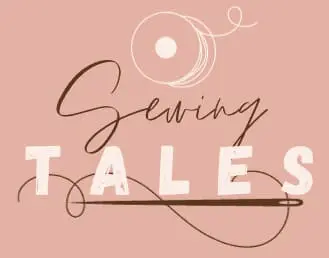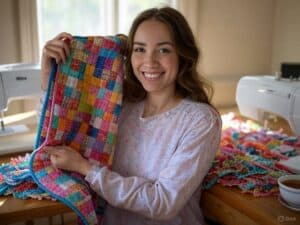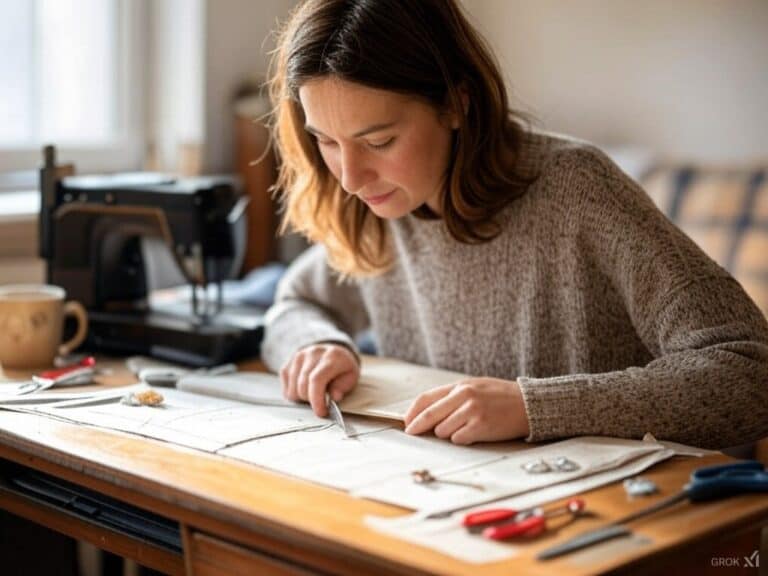Lily sat in her crafty cave, a blank piece of paper in front of her and a cup of tea by her side. She had started her sewing journey on a whim when she found her grandmother’s old sewing box. At first, the world of patterns, marks, and fabric was a bit overwhelming but soon she was hooked on the process of creating garments to her design.
Maybe you’ve felt the same excitement—or trepidation—about dress pattern cutting. In the world of fashion design, dress pattern cutting is a fundamental skill. Whether you’re a keen beginner like Lily or want to hone your skills, this guide will take you through it all. Let’s start with the basics so you can cut, adjust, and sew with confidence.

1. Essential Tools and Materials
Having the right tools is like laying the foundation for your sewing project. Lily learned this early on when she tried using kitchen scissors for fabric—it didn’t end well. To make your life easier here’s what you’ll need:
Additionally, you can find over 300 free sewing patterns as a source of inspiration for new projects.
Basic Pattern Cutting Tools
Fabric Scissors: These are the workhorses of your toolkit. Invest in a good pair and keep them only for cutting fabric. Sharp scissors mean clean, precise cuts and less fraying.
Rotary Cutter: This is a game changer for cutting, especially for straight lines or delicate fabrics like silk. Always use a self-healing cutting mat to protect your surface.
Ruler: A transparent ruler is essential for drawing straight lines and checking measurements. A long ruler with grid markings is particularly useful for pattern drafting.
Pattern Paper: The base of your patterns. Choose from:
- Tracing Paper: For transferring existing patterns. Thin and transparent so you can copy details accurately.
- Kraft Paper: Sturdy and reusable for drafting and testing designs.
- Muslin Fabric: A plain cotton fabric for creating muslins or testing garment fit before cutting the final fabric.
Measurement Tools and Marking Implements
Sewing is all about precision and these tools will help you achieve it:
Measuring Tape: Flexible, soft, and essential for taking body measurements.
Fabric Marking Pens or Chalk: Available in various colors these are for marking cutting lines, darts, and notches. Choose washable or disappearing ink for easy cleanup. Making precise markings, referred to as ‘dots’, during the garment construction process is critical for accurately transferring pattern details to the fabric.
Curve Ruler: A must-have for shaping necklines, armholes, and curved seams.
These are the building blocks of your dressmaking toolkit. Keep them tidy and ready for a stress-free sewing experience.
Adding personal style and fun to sewing projects is so much fun, as Ms. Snarky (@snarkychicklet) shows in a tweet from October 2023. She’s heading to Cabo in December for her birthday and that means a new birthday dress.
She chose the BurdaStyle pattern because of the cool diagonal cut at the top and plans to make the stripes vertical on the skirt. She wanted simplicity so no tiers, let the design speak for itself. This tweet is all about using dress patterns to bring your style to life and make cutting and sewing more fun.
I’m going to Cabo in December for my birthday so that means new birthday dress! I’ve picked out this pattern from BurdaStyle magazine. I really like the pieces cut on the diagonal on the top. I will make the stripes vertical on the skirt. No tiers either. pic.twitter.com/vV5YtbKZOo
— Ms. Snarky (@snarkychicklet) October 9, 2023
2. Understanding Pattern Basics
When Lily first unfolded a store-bought pattern the symbols and lines were overwhelming. But over time she came to see them as guides that made the sewing process easier. Understanding these basics will get you started. Additionally, understanding pattern basics is crucial for creating well-fitted dresses.
Common Pattern Markings and Symbols
Patterns have universal symbols that convey important information. Here’s a quick guide:
Notches: Small triangles or lines on pattern edges that indicate where pieces meet. Transfer these onto your fabric to ensure accurate construction.
Darts: Marked as triangles or diamond shapes, darts add shape and contour, particularly at the bust, waist, or hips.
Grainlines: Long arrows on pattern pieces that show the grain direction. Align these with the selvage for the correct drape.
Cutting Lines: Bold lines that indicate where to cut. Patterns often have multiple sizes so make sure you’re following the correct line for your measurements.
Fold Line: Where to fold the fabric. Place the pattern edge along the fold to avoid cutting seams.
Interpreting Pattern Instructions
Before you start cutting take time to read through the pattern instructions. They’re your guide to a successful garment. Focus on:
Fabric Recommendations: Make sure your fabric choice matches the pattern’s requirements. This affects drape, fit, and overall look.
Special Techniques: Patterns may require techniques like gathering, pleating, or inserting zippers. Read up on these before you start.
Assembly Order: Patterns have step-by-step instructions for constructing your garment. Follow these to avoid backtracking or mistakes.

3. Taking Accurate Measurements
As Lily found out, nothing can ruin a sewing project faster than bad measurements. Taking the time to measure correctly will mean your garment will fit beautifully.
Essential Body Measurements
These are the base of your pattern adjustments:
Bust: Measure around the fullest part of the chest, keeping the tape level and snug but not tight.
Waist: Wrap the tape around the narrowest part of your body, usually above the belly button.
Hips: Measure around the widest part of your hips and bottom.
Shoulder Width: From one shoulder to the other.
Back Length: From the base of your neck to your waist.
Skirt Length: From your waist to the hem.
Tips for Accuracy
- Stand up straight but relaxed while measuring.
- Wear the undergarments you’ll be wearing with the garment for best results.
- Record each measurement immediately, and if possible get a friend to help.
Mary Rizzo (@rizzo_pubhist) tweeted in December 2023 about the realities of dressmaking. She made handmade Christmas gifts for some family members and turned a shirt pattern into a dress for one of them by simply lengthening it. She used cotton lawns for the fabric. But it wasn’t without its challenges.
As she was working on the dress she got a bit too aggressive cutting open a buttonhole but was able to salvage the situation and fix it. This tweet shows how pattern adjustments can add a personal touch to handmade garments and the surprises that come with cutting and sewing.
Handmade Christmas gifts for some relatives. One wanted the shirt lengthened to a dress, but otherwise the same pattern, both in cotton lawn. Went well until I got too aggressive cutting open a buttonhole on the dress, but I think I fixed it. 🫥 pic.twitter.com/TMGElpfAks
— Mary Rizzo (@rizzo_pubhist) December 18, 2023
4. Pattern Layout and Fabric Preparation
Fabric preparation is boring but essential for professional and beautiful dressmaking results. By preparing your fabric correctly you’ll get accurate cuts and a smoother sewing experience with minimal surprises later on.
From pre-washing to ironing these small tasks are the foundation of a successful project. Take the time to give your fabric the attention it deserves—it’s the first step to turning your idea into reality.
Fabric Preparation
Pre-Wash: Wash your fabric to remove any chemicals and prevent future shrinkage. Follow the care instructions for your fabric type.
Iron: Iron out wrinkles for accurate cutting and alignment. Use the correct heat for your fabric.
Laying Out Patterns
Get your workspace ready before you lay out your fabric and patterns. Here’s how:
Align Grainlines: Match the grainline arrows on the pattern to the fabric’s selvage edge. Use a ruler to check.
Pin or Weigh Down Patterns: Pin or weigh down your pattern pieces so they don’t move while cutting.
Maximize Fabric: Arrange your pattern pieces to use the fabric to the best of its ability and any design motifs.

5. Cutting Techniques
Cutting is straightforward but requires focus to get a professional result. Every snip of the scissors or glide of the rotary cutter affects how the garment comes together so you must be deliberate. Perfect cuts will not only mean seamless assembly but also a better-looking and more durable garment.
Scissors vs Rotary Cutter
Scissors: Good for intricate cuts or curved edges. Use long, smooth strokes for straight lines. Keep your scissors sharp.
Rotary Cutter: Good for straight edges and layered fabrics. Always use a cutting mat.
Common Cutting Mistakes to Avoid
Not Pre-Washing: Shrinkage after sewing.
Ignoring Grainlines: Distorts your fabric.
Using Dull Tools: Frayed edges and uneven cuts.
Rushing: Take your time for accuracy and confidence.
A 4-year-old post from r/sewing where a user was working on the Avery Pencil Skirt pattern by Kdornbier Designs and shared a gif with a simple but important reminder: when the pattern says “cut on fold” don’t forget to do it! This is a great example of how easy it is to overlook the small stuff when you’re distracted. Even experienced sewists can have a brain fart now and then and it’s a good reminder to stay focused on the pattern instructions.
When a pattern says ‘cut on fold’, don’t forget to do it… Wonder what distracted me? Avery Pencil Skirt pattern by kdornbier designs
byu/GifGif insewing
6. Pattern Adjustments and Customization
Adjusting patterns allows you to create garments that fit your unique measurements and your style. Whether you want to shorten a hemline, accommodate a fuller bust, or modify a waistline you can adjust patterns to fit your body shape.
Through careful adjustments and test garments like muslin mock-ups, you can experiment and refine your designs until they are perfect. This process not only improves the fit of your garments but also opens up endless possibilities for creativity and individuality.
Basic Adjustments
Lengthening/Shortening: Add or remove length at the designated lines.
Taking In/Letting Out: Pin fabric to test fit before sewing.
Waistline Adjustments: Raise or lower to your natural waist.

Make a Mock-Up
Like Lily, it’s a good idea to start with a muslin mock-up. This inexpensive, plain fabric allows you to test the pattern without using your final fabric. A test garment gives you the chance to see how the pattern fits and drapes on you and to identify and fix any fitting issues before you cut into your more expensive or delicate fabric.
This step is key so you can make any adjustments needed—shorten the hemline, adjust the bust or waist, or change the overall fit—without worrying about wasting your good fabric. It’s a process that will give you a better outcome as you can perfect the fit, shape, and comfort of your design.
Your Next Step
By the time Lily finished her first dress she felt proud. The pattern was intimidating, the cutting was tedious and the adjustments were hard. But when she put the finished garment on she was glad she did. She had created something that was hers – proof that patience and practice work.
Go for it! With the right tools, skills, and a bit of courage you can cut dress patterns. Every garment is a story and every story starts with that first cut. Today, start and show off your creativity—your dream dress is a pattern away!







